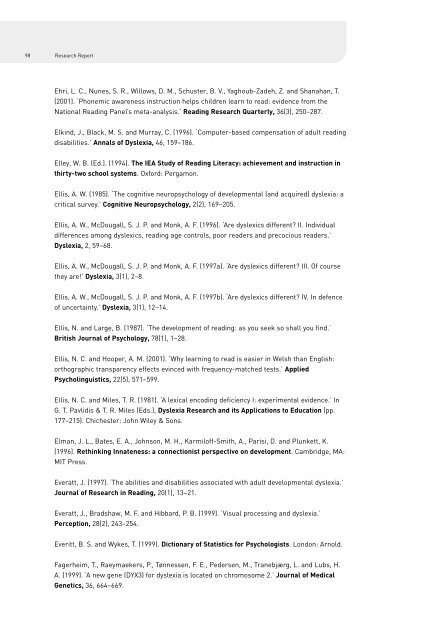01 NRDC Dyslexia 1-88 update - Texthelp
01 NRDC Dyslexia 1-88 update - Texthelp
01 NRDC Dyslexia 1-88 update - Texthelp
You also want an ePaper? Increase the reach of your titles
YUMPU automatically turns print PDFs into web optimized ePapers that Google loves.
98<br />
Research Report<br />
Ehri, L. C., Nunes, S. R., Willows, D. M., Schuster, B. V., Yaghoub-Zadeh, Z. and Shanahan, T.<br />
(20<strong>01</strong>). ‘Phonemic awareness instruction helps children learn to read: evidence from the<br />
National Reading Panel’s meta-analysis.’ Reading Research Quarterly, 36(3), 250–287.<br />
Elkind, J., Black, M. S. and Murray, C. (1996). ‘Computer-based compensation of adult reading<br />
disabilities.’ Annals of <strong>Dyslexia</strong>, 46, 159–186.<br />
Elley, W. B. (Ed.). (1994). The IEA Study of Reading Literacy: achievement and instruction in<br />
thirty-two school systems. Oxford: Pergamon.<br />
Ellis, A. W. (1985). ‘The cognitive neuropsychology of developmental (and acquired) dyslexia: a<br />
critical survey.’ Cognitive Neuropsychology, 2(2), 169–205.<br />
Ellis, A. W., McDougall, S. J. P. and Monk, A. F. (1996). ‘Are dyslexics different? II. Individual<br />
differences among dyslexics, reading age controls, poor readers and precocious readers.’<br />
<strong>Dyslexia</strong>, 2, 59–68.<br />
Ellis, A. W., McDougall, S. J. P. and Monk, A. F. (1997a). ‘Are dyslexics different? III. Of course<br />
they are!’ <strong>Dyslexia</strong>, 3(1), 2–8.<br />
Ellis, A. W., McDougall, S. J. P. and Monk, A. F. (1997b). ‘Are dyslexics different? IV. In defence<br />
of uncertainty.’ <strong>Dyslexia</strong>, 3(1), 12–14.<br />
Ellis, N. and Large, B. (1987). ‘The development of reading: as you seek so shall you find.’<br />
British Journal of Psychology, 78(1), 1–28.<br />
Ellis, N. C. and Hooper, A. M. (20<strong>01</strong>). ‘Why learning to read is easier in Welsh than English:<br />
orthographic transparency effects evinced with frequency-matched tests.’ Applied<br />
Psycholinguistics, 22(5), 571–599.<br />
Ellis, N. C. and Miles, T. R. (1981). ‘A lexical encoding deficiency I: experimental evidence.’ In<br />
G. T. Pavlidis & T. R. Miles (Eds.), <strong>Dyslexia</strong> Research and its Applications to Education (pp.<br />
177–215). Chichester: John Wiley & Sons.<br />
Elman, J. L., Bates, E. A., Johnson, M. H., Karmiloff-Smith, A., Parisi, D. and Plunkett, K.<br />
(1996). Rethinking Innateness: a connectionist perspective on development. Cambridge, MA:<br />
MIT Press.<br />
Everatt, J. (1997). ‘The abilities and disabilities associated with adult developmental dyslexia.’<br />
Journal of Research in Reading, 20(1), 13–21.<br />
Everatt, J., Bradshaw, M. F. and Hibbard, P. B. (1999). ‘Visual processing and dyslexia.’<br />
Perception, 28(2), 243–254.<br />
Everitt, B. S. and Wykes, T. (1999). Dictionary of Statistics for Psychologists. London: Arnold.<br />
Fagerheim, T., Raeymaekers, P., Tønnessen, F. E., Pedersen, M., Tranebjærg, L. and Lubs, H.<br />
A. (1999). ‘A new gene (DYX3) for dyslexia is located on chromosome 2.’ Journal of Medical<br />
Genetics, 36, 664–669.
















